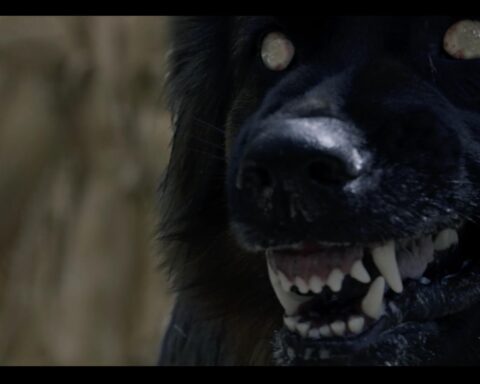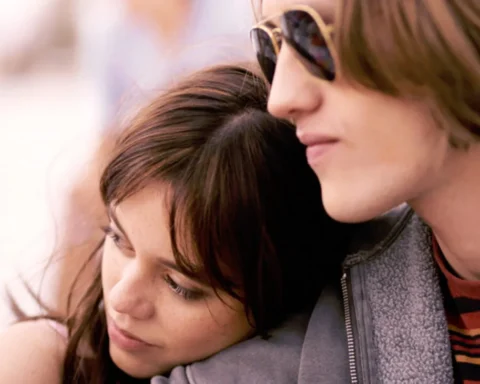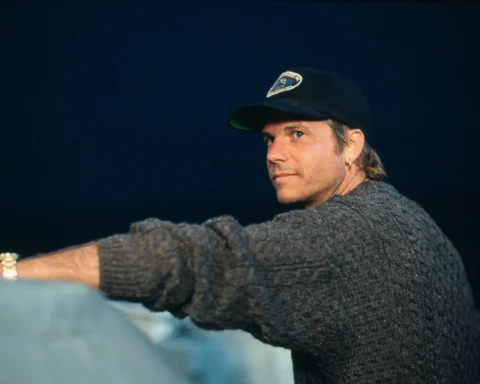Horror cinema has long been a mirror reflecting society’s fears, anxieties, and cultural taboos. Women, in particular, have played pivotal roles in horror films, serving as both the embodiment of terror and the source of it. From the early days of the genre, women were often cast as the innocent victims, the damsels in distress who would scream at the sight of a monster or flee from a menacing killer. However, as the genre evolved, so too did the roles of women. No longer confined to the role of the helpless victim, women in horror have become complex characters, often embodying resilience, strength, and agency.
This transformation is not just a reflection of changing societal attitudes towards women but also a testament to the incredible performances of actresses who have redefined what it means to be a woman in horror. These actresses have taken on roles that challenge traditional gender norms, explore psychological depths, and, in some cases, even turn the tables on their male counterparts. This essay will delve into the careers and contributions of some of the most influential women in horror, examining how their performances have shaped the genre and influenced the portrayal of women on screen.
The actresses discussed in this essay have not only contributed to the horror genre but have also become icons in their own right. Jamie Lee Curtis, often referred to as the original “Scream Queen,” set the standard for the Final Girl trope with her portrayal of Laurie Strode in the “Halloween” franchise. Neve Campbell, who took up the mantle in the “Scream” series, brought a modern twist to the Final Girl, balancing vulnerability with fierce determination. On the other hand, actresses like Jennifer Tilly and Anya Taylor-Joy have pushed the boundaries of horror by exploring roles that combine dark humor, psychological horror, and complex character studies.
The modern horror landscape is also being shaped by a new generation of actresses like Mia Goth, Samara Weaving, and Lupita Nyong’o, who bring fresh perspectives and unique talents to the genre. These actresses are not just stars but are also redefining what horror can be in terms of storytelling, character development, and thematic exploration.
Chapter 1: The Evolution of Women in Horror Films
The portrayal of women in horror films has undergone significant changes over the decades. In the early years of horror cinema, women were often relegated to roles that emphasized their vulnerability and helplessness. The classic image of the “damsel in distress” became a staple of the genre, with female characters often serving as little more than a plot device to be rescued or avenged. Films like “Dracula” (1931) and “King Kong” (1933) featured women who were primarily there to scream and faint at the sight of the monstrous other, reinforcing the idea that women were inherently weaker and in need of protection.
However, as societal attitudes towards women began to change, so too did their roles in horror films. The 1970s and 1980s saw the rise of the Final Girl trope, a concept that would become central to the slasher subgenre. The Final Girl is typically the last woman standing, the one who confronts the killer and either escapes or defeats them. This trope was popularized by films like “Halloween” (1978), “Friday the 13th” (1980), and “A Nightmare on Elm Street” (1984). The Final Girl was a significant departure from the earlier depictions of women in horror, as she was not only a survivor but also often resourceful, intelligent, and capable of fighting back.
Yet, the Final Girl trope was not without its criticisms. Some argued that while the Final Girl was a step forward in terms of agency, she was often depicted as asexual, virtuous, and devoid of any real personality beyond her survival instincts. This led to a new wave of horror films in the 1990s and 2000s that sought to further complicate the portrayal of women in the genre. Characters like Sidney Prescott in the “Scream” series and Laurie Strode in the later “Halloween” films were given more depth, exploring their psychological trauma and the lasting impact of their experiences.
Today, women in horror films are more diverse and complex than ever before. Actresses like Lupita Nyong’o, Toni Collette, and Anya Taylor-Joy have taken on roles that challenge traditional gender norms and explore themes of motherhood, trauma, and mental illness. These performances have not only expanded the possibilities for women in horror but have also pushed the genre itself into new and exciting directions.
Chapter 2: Jamie Lee Curtis – The Original Scream Queen
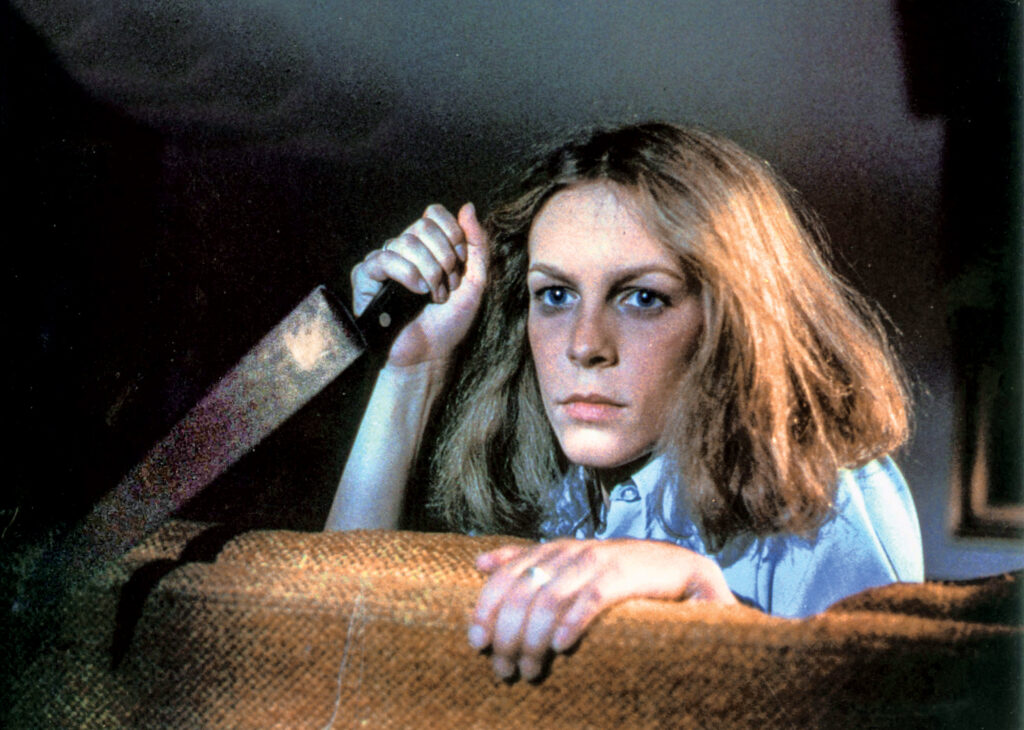
When discussing women in horror, it is impossible to overlook Jamie Lee Curtis, whose portrayal of Laurie Strode in John Carpenter’s “Halloween” (1978) set the standard for the Final Girl trope. Laurie Strode is not just any Final Girl; she is the archetype upon which many subsequent characters were modeled. In the original “Halloween,” Laurie is a shy, bookish teenager who finds herself the target of the masked killer Michael Myers. Unlike her more carefree friends, Laurie is cautious and responsible, traits that ultimately help her survive the night.
Curtis’s performance as Laurie Strode was groundbreaking in its portrayal of a female character who, while terrified, is also resourceful and determined. She fights back against Michael Myers with whatever she can find, from knitting needles to coat hangers, embodying the idea that survival is as much about wit and resolve as it is about physical strength. Laurie’s battle with Michael Myers would continue in several sequels, with Curtis reprising her role multiple times over the years.
The character of Laurie Strode and Jamie Lee Curtis’s portrayal of her had a profound impact on the horror genre. Laurie became the blueprint for the Final Girl, a character who is often the moral center of the film and whose survival is linked to her purity, intelligence, and determination. However, what made Laurie Strode stand out was not just her ability to survive, but the emotional depth that Curtis brought to the role. Laurie is not a superhero; she is a young woman thrust into an unimaginable situation, and Curtis’s portrayal captures the fear, trauma, and resilience that comes with that.
In the 2018 reboot of “Halloween,” Curtis returned to the role of Laurie Strode, this time portraying her as a woman who has spent her entire life preparing for Michael Myers’s return. The film explores the long-term effects of trauma, with Laurie depicted as a paranoid, reclusive figure who has been estranged from her family due to her obsession with Myers. This portrayal added new layers to the character, transforming Laurie from a Final Girl into a complex, flawed woman grappling with the aftermath of her experiences. Curtis’s performance was widely praised for its depth and nuance, proving that even 40 years after the original film, she remains one of the most iconic figures in horror.
Chapter 3: Neve Campbell – The Modern Scream Queen

If Jamie Lee Curtis is the original Scream Queen, then Neve Campbell is her modern counterpart. Campbell’s portrayal of Sidney Prescott in Wes Craven’s “Scream” series redefined the Final Girl trope for a new generation. “Scream” (1996) was a game-changer for the horror genre, as it combined self-aware humor with genuine scares. At the heart of the film was Sidney Prescott, a character who would come to represent the next evolution of the Final Girl.
Sidney Prescott is a far cry from the virginal Final Girls of the 1980s. While she shares their resourcefulness and resilience, she is also depicted as a fully realized character with her own flaws, fears, and desires. The “Scream” series explores Sidney’s journey from a traumatized teenager to a strong, independent woman who refuses to be defined by her past. Throughout the series, Sidney faces numerous killers who take on the mantle of Ghostface, but she consistently outsmarts them, using both her intellect and her physical strength to survive.
One of the key elements of Sidney Prescott’s character is her awareness of horror tropes. “Scream” is a meta-horror film that often references and subverts the conventions of the genre, and Sidney is fully aware of the rules that govern horror movies. This self-awareness allows her to navigate the dangers she faces more effectively, making her one of the most capable and intelligent Final Girls in horror history.
Neve Campbell’s performance as Sidney Prescott was crucial to the success of the “Scream” series. Campbell brought a sense of realism and vulnerability to the role, making Sidney a relatable and sympathetic character. At the same time, she also portrayed Sidney’s strength and determination, creating a character who could be both emotionally complex and physically formidable. Sidney Prescott is a character who evolves over the course of the series, and Campbell’s portrayal captures this growth beautifully.
The “Scream” series also explores the impact of trauma on Sidney’s life, much like the later portrayals of Laurie Strode in the “Halloween” films. Sidney is a character who has faced unimaginable horrors, and the series does not shy away from showing the psychological toll this takes on her. However, Sidney is also a character who refuses to be a victim. She fights back against the killers who target her, not just to survive, but to reclaim her life and her agency. In this way, Sidney Prescott represents the next step in the evolution of the Final Girl, a character who is not just a survivor, but a fighter.
Chapter 4: Jennifer Tilly – The Killer Bride

While many actresses have made their mark in horror by playing the victim or the Final Girl, Jennifer Tilly stands out for her portrayal of a character who is anything but. Tilly’s role as Tiffany Valentine in the “Child’s Play” series is one of the most memorable and iconic female villains in horror history. Tiffany is introduced in “Bride of Chucky” (1998) as the girlfriend of the notorious killer doll, Chucky. After being killed by Chucky, Tiffany’s soul is transferred into a doll, and she becomes his partner in crime.
What makes Tiffany Valentine such a fascinating character is the way she combines elements of horror and dark comedy. Tilly’s performance is both campy and menacing, creating a character who is as funny as she is terrifying. Tiffany is a complex character who loves Chucky but is also deeply frustrated by his lack of appreciation for her. This dynamic adds a layer of dark humor to the series, as Tiffany and Chucky’s relationship becomes a twisted parody of a dysfunctional marriage.
Tilly’s portrayal of Tiffany also challenges traditional gender roles in horror. While female villains in horror are often depicted as either seductresses or monstrous figures, Tiffany is a character who embodies both. She is seductive, but she is also violent and ruthless. At the same time, Tilly’s performance brings a sense of vulnerability to the character, making Tiffany a more sympathetic and relatable figure than one might expect. This blend of traits makes Tiffany one of the most unique and memorable characters in horror.
In addition to her role as Tiffany Valentine, Jennifer Tilly has also had a significant impact on the horror genre through her voice work. She has lent her voice to several animated horror projects, bringing her distinctive style to a variety of characters. Tilly’s contributions to horror go beyond her roles in the “Child’s Play” series, as she has become a beloved figure in the genre, known for her wit, charm, and unique approach to horror.
Chapter 5: Anya Taylor-Joy – The New Face of Psychological Horror

Anya Taylor-Joy is one of the most exciting and versatile actresses to emerge in recent years, and her work in horror has quickly made her a standout in the genre. Taylor-Joy’s breakthrough role came in Robert Eggers’s “The Witch” (2015), where she played Thomasin, a young girl living in 17th-century New England. The film is a slow-burning exploration of religious paranoia and the fear of the unknown, and Taylor-Joy’s performance as Thomasin is central to its impact.
Thomasin is a complex character, caught between the strict religious beliefs of her family and her own burgeoning independence. Taylor-Joy’s performance captures the fear, confusion, and ultimately the empowerment that Thomasin experiences as she comes to terms with her own identity and the supernatural forces at play. “The Witch” is a film that relies heavily on atmosphere and psychological tension, and Taylor-Joy’s performance is essential to creating that sense of unease.
Following “The Witch,” Taylor-Joy continued to explore the psychological depths of horror with her role as Casey Cooke in M. Night Shyamalan’s “Split” (2016) and its sequel “Glass” (2019). Casey is a young woman who is kidnapped by a man with multiple personalities, played by James McAvoy. Throughout the film, Casey’s traumatic past is revealed, and Taylor-Joy’s portrayal of a survivor of abuse adds a layer of emotional depth to the character. Casey is not just a victim; she is a fighter, and her ability to empathize with the different personalities of her captor ultimately helps her survive.
Anya Taylor-Joy’s work in horror is characterized by her ability to bring a sense of realism and emotional complexity to her roles. Whether she is playing a young girl in a puritanical society or a survivor of trauma, Taylor-Joy’s performances are always grounded in a deep understanding of her characters’ psychological states. This makes her one of the most compelling actresses in modern horror, as she consistently chooses roles that challenge traditional notions of what it means to be a woman in the genre.
In addition to her work in horror, Taylor-Joy has also become known for her roles in other genres, showcasing her versatility as an actress. However, it is her work in horror that has truly set her apart as a rising star, as she continues to choose roles that push the boundaries of the genre and explore complex themes of identity, trauma, and empowerment.
Chapter 6: Mia Goth – Subversion and Madness
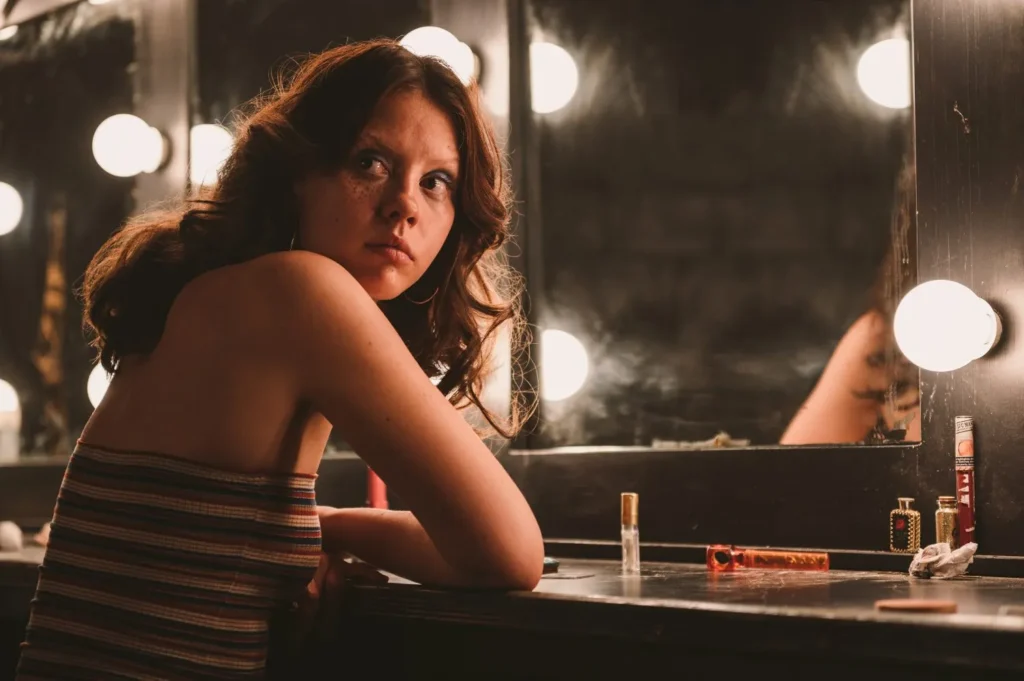
Mia Goth is one of the most intriguing actresses in modern horror, known for her ability to navigate roles that blur the line between victim and villain. Her performances often explore the psychological unraveling of her characters, making her a standout figure in a genre that thrives on tension and unpredictability. Goth’s work in horror is marked by a deep engagement with the genre’s darkest themes, from madness and obsession to the subversion of traditional gender roles.
Goth’s most significant contributions to the horror genre have come through her collaboration with director Ti West, particularly in the films “X” (2022) and its prequel, “Pearl” (2022). In “X,” Goth plays two roles: Maxine Minx, a young woman with dreams of becoming a star in the adult film industry, and Pearl, an elderly woman living on the farm where the film is set. The dual roles allowed Goth to showcase her range as an actress, portraying both the innocence and ambition of Maxine and the twisted, murderous impulses of Pearl.
“X” is a film that explores themes of sexuality, repression, and the horror of aging. Goth’s portrayal of Pearl, in particular, is haunting, as she captures the character’s jealousy and rage towards the younger generation. Pearl’s desire for youth and beauty drives her to commit horrific acts, and Goth’s performance brings a tragic depth to the character. The duality of Maxine and Pearl—both played by Goth—highlights the film’s exploration of the cyclical nature of desire and the ways in which society marginalizes older women.
In the prequel “Pearl,” Goth delves even deeper into the character of Pearl, exploring her origins and the factors that led to her descent into madness. The film is set in the early 20th century and provides a backstory for the character, revealing her dreams of escaping the confines of her rural life and becoming a star. Goth’s portrayal of Pearl in this film is both sympathetic and terrifying, as she captures the character’s desperation and the gradual erosion of her sanity.
Goth’s performances in “X” and “Pearl” are significant not only for their complexity but also for the way they challenge traditional horror tropes. In many horror films, women who embrace their sexuality or defy societal norms are punished, often becoming victims of the narrative. However, Goth’s characters are neither wholly victims nor villains; they are complex, multifaceted individuals whose actions are shaped by their circumstances and desires. This subversion of expectations adds a layer of depth to the films and positions Goth as one of the most compelling actresses working in horror today.
Beyond her work in the “X” series, Goth has also appeared in other horror films that further showcase her ability to navigate psychological complexity. In “A Cure for Wellness” (2016), she plays Hannah, a mysterious young woman trapped in a nightmarish health spa. The film, directed by Gore Verbinski, is a psychological horror that explores themes of control, obsession, and the fear of the unknown. Goth’s portrayal of Hannah is both ethereal and unsettling, as she embodies a character who is both innocent and deeply damaged.
Mia Goth’s contributions to the horror genre are characterized by her willingness to take on roles that challenge traditional narratives and explore the darker aspects of the human psyche. Her performances are marked by a deep understanding of her characters’ inner lives, making her one of the most exciting and innovative actresses in modern horror.
Chapter 7: Samara Weaving – The Action-Packed Final Girl

Samara Weaving has quickly become one of the most recognizable faces in modern horror, known for her roles in films that blend horror with action and dark comedy. Weaving’s characters are often placed in extreme situations where they must rely on their wits and physical prowess to survive. Her performances bring a fresh, energetic take to the Final Girl trope, infusing it with a sense of humor and a willingness to get her hands dirty.
One of Weaving’s most notable roles is that of Grace Le Domas in the horror-comedy “Ready or Not” (2019). The film, directed by Matt Bettinelli-Olpin and Tyler Gillett, tells the story of Grace, a young bride who is forced to play a deadly game of hide-and-seek with her new in-laws on her wedding night. The film is a satirical take on wealth and privilege, with Grace fighting for her life against a family that has made a pact with the devil.
Weaving’s portrayal of Grace is a masterclass in balancing horror and humor. From the moment the game begins, Grace transforms from a bewildered bride into a fierce survivor, using whatever she can find to defend herself. Weaving’s performance is both intense and darkly funny, as she navigates the increasingly absurd and violent situations that arise. Grace is a character who refuses to be a victim, and Weaving’s portrayal highlights her resourcefulness and determination.
“Ready or Not” is also notable for the way it subverts the typical Final Girl narrative. Grace is not a passive character waiting to be rescued; she is an active participant in her survival, often taking the fight to her attackers. The film’s blend of horror and satire allows Weaving to explore themes of power, class, and agency, making Grace one of the most memorable horror heroines of recent years.
Weaving has continued to build on her reputation as a horror star with roles in other genre films, such as “The Babysitter” (2017) and its sequel, “The Babysitter: Killer Queen” (2020). In these films, directed by McG, Weaving plays Bee, a babysitter with a dark secret who is involved in a satanic cult. The films are a mix of horror, comedy, and action, and Weaving’s performance as Bee is both charismatic and menacing. She brings a sense of fun to the role, embracing the over-the-top nature of the films while also delivering genuine scares.
In addition to her work in horror, Weaving has also appeared in action films, further cementing her status as a versatile actress who excels in physically demanding roles. Her ability to combine humor, horror, and action has made her a favorite among horror fans, and her performances continue to push the boundaries of what it means to be a Final Girl.
Samara Weaving’s contributions to the horror genre are significant for the way they challenge and expand the traditional Final Girl trope. Her characters are not just survivors; they are fighters who take control of their own destinies, often with a wink and a smile. Weaving’s performances bring a sense of energy and excitement to the genre, making her one of the most dynamic actresses in modern horror.
Chapter 8: Lupita Nyong’o – Duality and Terror

Lupita Nyong’o’s foray into horror with Jordan Peele’s “Us” (2019) was a game-changer for both the genre and the portrayal of women in horror. Nyong’o’s dual role as Adelaide Wilson and her doppelgänger, Red, is a masterclass in acting, showcasing her incredible range and ability to convey complex emotions. “Us” is a film that delves into themes of identity, trauma, and the fear of the other, and Nyong’o’s performances are central to its impact.
In “Us,” Nyong’o plays Adelaide, a woman who is haunted by a traumatic event from her childhood when she encountered her doppelgänger in a funhouse. As an adult, Adelaide is a loving mother and wife, but she is plagued by a sense of unease and fear that something is coming for her. Nyong’o’s portrayal of Adelaide is layered and nuanced, capturing the character’s strength, vulnerability, and deep-seated terror.
The film takes a dramatic turn when Adelaide’s family is confronted by their doppelgängers, known as the Tethered. Nyong’o’s portrayal of Red, Adelaide’s double, is chilling and unforgettable. Red speaks in a raspy, halting voice, and her movements are jerky and unnatural, creating a stark contrast to Adelaide’s warmth and humanity. Nyong’o’s ability to convey the physical and psychological differences between the two characters is astounding, making Red one of the most terrifying and memorable villains in recent horror history.
What makes Nyong’o’s performance in “Us” so significant is the way it explores the duality of her characters. Adelaide and Red are two sides of the same coin, representing the privileged and the oppressed, the self and the other. The film’s exploration of this duality is a commentary on social and racial inequalities, and Nyong’o’s performances bring these themes to life in a visceral and emotionally resonant way.
Nyong’o’s work in “Us” also challenges traditional representations of black women in horror. Historically, black women have often been marginalized or reduced to stereotypes in the genre. However, Nyong’o’s portrayal of Adelaide and Red is complex and multifaceted, offering a new vision of what black women in horror can be. Adelaide is not just a survivor; she is a fully realized character with her own fears, strengths, and agency. Red, on the other hand, is a character who embodies the rage and pain of the marginalized, making her both a tragic and terrifying figure.
The critical and commercial success of “Us” cemented Nyong’o’s status as a leading actress in horror and highlighted the importance of diverse representation in the genre. Her performances in the film are a testament to her incredible talent and her ability to bring depth and nuance to characters who might otherwise be reduced to mere archetypes. Nyong’o’s work in “Us” has opened the door for more complex and diverse portrayals of women in horror, making her one of the most important figures in the genre today.
Chapter 9: Vera Farmiga – The Face of Modern Supernatural Horror
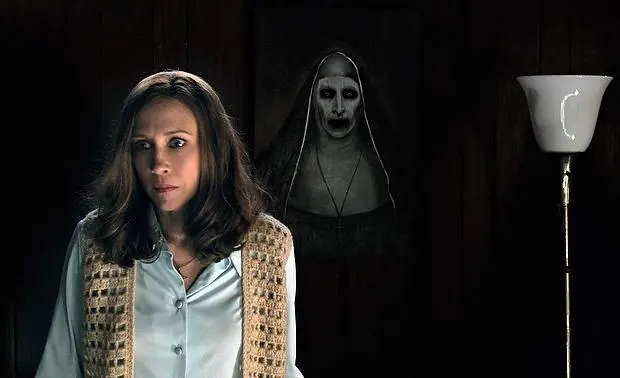
Vera Farmiga has become synonymous with supernatural horror, thanks to her role as Lorraine Warren in “The Conjuring” series. Farmiga’s portrayal of Lorraine, a real-life paranormal investigator, has made her a central figure in one of the most successful horror franchises of all time. Her performances are marked by a sense of empathy, strength, and emotional depth, making Lorraine Warren one of the most beloved characters in modern horror.
“The Conjuring” (2013), directed by James Wan, introduced audiences to Ed and Lorraine Warren, a husband-and-wife team of paranormal investigators. Farmiga’s portrayal of Lorraine is both warm and authoritative, as she brings a sense of compassion and understanding to the character. Lorraine is depicted as a woman with strong religious beliefs and a deep connection to the supernatural, which allows her to empathize with the families she helps.
One of the most compelling aspects of Farmiga’s performance is the way she conveys Lorraine’s sensitivity to the supernatural. Lorraine is not just a bystander to the horrors she encounters; she feels them deeply, often at great personal cost. Farmiga’s portrayal captures the emotional toll that Lorraine’s work takes on her, as she grapples with the fear and sadness that comes with confronting evil. This emotional depth sets Lorraine apart from many other characters in supernatural horror, who are often depicted as either fearless or entirely consumed by terror.
Farmiga’s portrayal of Lorraine Warren also highlights the importance of faith and love in the face of horror. Throughout “The Conjuring” series, Lorraine’s relationship with her husband Ed, played by Patrick Wilson, is a central focus. The couple’s love and devotion to each other are depicted as their greatest strength, allowing them to face the horrors they encounter with courage and resilience. This focus on the power of love and faith adds a unique dimension to the series, setting it apart from other horror franchises that rely solely on fear and gore.
In addition to her work in “The Conjuring” series, Farmiga has also appeared in other horror films that showcase her range as an actress. In “Orphan” (2009), she plays Kate Coleman, a mother who adopts a young girl with a dark secret. The film is a psychological horror that explores themes of motherhood, grief, and identity. Farmiga’s portrayal of Kate is both vulnerable and fierce, as she uncovers the truth about her adopted daughter and fights to protect her family.
Farmiga’s contributions to horror are significant not only for her performances but also for the way she has helped to elevate the genre. Her work in “The Conjuring” series, in particular, has brought a sense of gravitas and emotional depth to supernatural horror, making it accessible to a broader audience. Farmiga’s portrayal of Lorraine Warren has become iconic, and her performances continue to be a highlight of the genre.
Chapter 10: Christina Ricci – From Wednesday Addams to Gothic Horror Icon

Christina Ricci’s career in horror began at a young age, with her portrayal of Wednesday Addams in “The Addams Family” (1991) and its sequel “Addams Family Values” (1993). Ricci’s performance as the morbid, deadpan Wednesday became iconic, cementing her status as a beloved figure in the genre. However, Ricci’s contributions to horror extend far beyond her role as Wednesday, as she has continued to explore dark and gothic themes throughout her career.
After her breakout role as Wednesday Addams, Ricci went on to star in several horror films that showcased her ability to navigate complex and often disturbing characters. In “Sleepy Hollow” (1999), directed by Tim Burton, Ricci plays Katrina Van Tassel, the love interest of Ichabod Crane, played by Johnny Depp. The film is a gothic horror that blends supernatural elements with a murder mystery, and Ricci’s portrayal of Katrina is both ethereal and enigmatic.
“Sleepy Hollow” is notable for its gothic atmosphere and dark visual style, and Ricci’s performance fits seamlessly into this world. Katrina is a character who is both innocent and mysterious, and Ricci’s portrayal captures this duality beautifully. Her work in the film highlights her ability to embody characters who are both vulnerable and strong, making her a perfect fit for the gothic horror genre.
Ricci has also explored psychological horror in films such as “The Lizzie Borden Chronicles” (2015), a television series in which she plays the infamous Lizzie Borden, a woman accused of murdering her parents with an axe. Ricci’s portrayal of Lizzie is chilling and intense, as she delves into the mind of a character who is both victim and villain. The series blends historical fact with fiction, and Ricci’s performance brings a sense of authenticity and complexity to the character.
Throughout her career, Christina Ricci has embraced roles that explore the darker side of human nature, often playing characters who are outsiders or who possess a certain degree of moral ambiguity. This has made her a beloved figure in the horror genre, as she consistently chooses roles that challenge traditional narratives and offer new perspectives on what it means to be a woman in horror.
Ricci’s contributions to the genre are significant not only for her performances but also for the way she has helped to shape the modern gothic horror aesthetic. Her work in films like “Sleepy Hollow” and “The Lizzie Borden Chronicles” has solidified her status as a gothic horror icon, and her influence can be seen in the way the genre continues to evolve. Ricci’s commitment to exploring dark and complex characters has made her one of the most respected actresses in horror, and her impact on the genre is undeniable.
Chapter 11: Toni Collette – The Matriarch of Horror

Toni Collette’s work in horror has been nothing short of groundbreaking, with performances that have redefined the role of the mother in the genre. Collette is known for her ability to convey deep emotional complexity, often playing characters who are grappling with grief, trauma, and madness. Her work in horror is characterized by a raw, visceral intensity that has made her one of the most acclaimed actresses in the genre.
Collette’s most significant contribution to horror came with her role as Annie Graham in Ari Aster’s “Hereditary” (2018). The film is a psychological horror that explores themes of family, grief, and inherited trauma. Collette’s portrayal of Annie, a mother who is struggling to cope with the death of her own mother and the dark secrets that are revealed in the aftermath, is one of the most powerful performances in recent horror history.
Annie is a character who is deeply flawed and often difficult to sympathize with, yet Collette’s performance brings a sense of humanity and vulnerability to the role. As Annie’s world begins to unravel, Collette captures the character’s descent into madness with a terrifying intensity. Her performance in “Hereditary” is marked by a physical and emotional rawness that is rarely seen in horror, making Annie one of the most compelling and tragic figures in the genre.
One of the most striking aspects of Collette’s performance in “Hereditary” is the way she conveys the horror of motherhood. Annie’s relationship with her children is fraught with tension and resentment, and the film explores the ways in which these emotions can fester and manifest in destructive ways. Collette’s portrayal of Annie challenges the traditional image of the nurturing, self-sacrificing mother, offering instead a character who is consumed by grief, anger, and guilt.
In addition to “Hereditary,” Collette has also appeared in other horror films that further showcase her range as an actress. In “The Sixth Sense” (1999), she plays Lynn Sear, the mother of a young boy who can see ghosts. While “The Sixth Sense” is more of a supernatural thriller than a traditional horror film, Collette’s performance is still a standout. Her portrayal of Lynn is marked by a quiet strength and a deep love for her son, even as she struggles to understand and protect him.
Collette’s contributions to horror are significant not only for her performances but also for the way she has helped to elevate the genre. Her work in films like “Hereditary” has brought a new level of emotional depth and complexity to horror, challenging traditional narratives and offering new perspectives on the role of women in the genre. Collette’s performances are often harrowing and deeply affecting, making her one of the most important actresses in modern horror.
Chapter 12: Melissa Barrera and Jenna Ortega – The Future of Horror

Melissa Barrera and Jenna Ortega represent the next generation of women in horror, bringing fresh perspectives and new energy to the genre. Both actresses have quickly made a name for themselves with performances that challenge traditional horror tropes and explore complex themes of identity, survival, and empowerment. Their work is indicative of a new wave of horror that is more diverse, inclusive, and reflective of contemporary issues.
Melissa Barrera’s breakthrough role in horror came with her performance as Sam Carpenter in “Scream” (2022), the fifth installment of the iconic “Scream” franchise. Sam is introduced as the daughter of Billy Loomis, one of the original Ghostface killers from the first “Scream” film. This connection to the original film adds a layer of complexity to Sam’s character, as she grapples with her family’s dark legacy while trying to survive a new wave of Ghostface attacks.
Barrera’s portrayal of Sam is both intense and nuanced, as she captures the character’s fear, anger, and determination. Sam is a character who is deeply conflicted, struggling with her identity and the weight of her father’s legacy. Barrera’s performance brings a sense of vulnerability and strength to the role, making Sam a compelling and relatable heroine for a new generation of horror fans.
In addition to her work in “Scream,” Barrera has also appeared in other horror films that explore themes of survival and resilience. In “The Evil Dead Rise” (2023), she plays Beth, a woman who must protect her family from a demonic force. The film is a brutal and intense addition to the “Evil Dead” franchise, and Barrera’s performance as Beth is a highlight. Her portrayal of a mother fighting to protect her children adds a new dimension to the film, making it a standout in the franchise.
Jenna Ortega, like Barrera, has quickly become a rising star in horror, known for her roles in films and television series that blend horror with social commentary. Ortega’s performances are marked by a sense of authenticity and emotional depth, making her one of the most exciting young actresses in the genre.
Ortega’s breakout role in horror came with her performance in the television series “You” (2019-2021), where she played Ellie Alves, a teenager who becomes entangled in the dark world of the show’s protagonist, Joe Goldberg. Ortega’s portrayal of Ellie is both smart and vulnerable, as she navigates the dangers of Joe’s world while trying to protect her sister. The role showcased Ortega’s ability to convey complex emotions and brought her widespread acclaim.
Ortega further solidified her status as a horror star with her role as Tara Carpenter in “Scream” (2022). As Sam’s younger sister, Tara is a central figure in the film’s new generation of characters. Ortega’s performance as Tara is both fierce and relatable, as she fights to survive the latest Ghostface attacks. Tara’s relationship with her sister Sam adds an emotional core to the film, and Ortega’s portrayal captures the fear and determination that drives her character.
In addition to “Scream,” Ortega has also appeared in other horror projects, including the Netflix series “Wednesday” (2022), a darkly comedic take on the character Wednesday Addams from “The Addams Family.” Ortega’s portrayal of Wednesday is both faithful to the original character and infused with a modern sensibility, making it a hit with audiences.
Melissa Barrera and Jenna Ortega represent the future of horror, bringing new perspectives and energy to a genre that is constantly evolving. Their performances are a testament to the power of horror to explore complex themes and challenge traditional narratives. As they continue to build their careers in the genre, Barrera and Ortega are poised to become leading figures in the next wave of horror cinema.
Chapter 13: Maika Monroe – The New Face of Horror
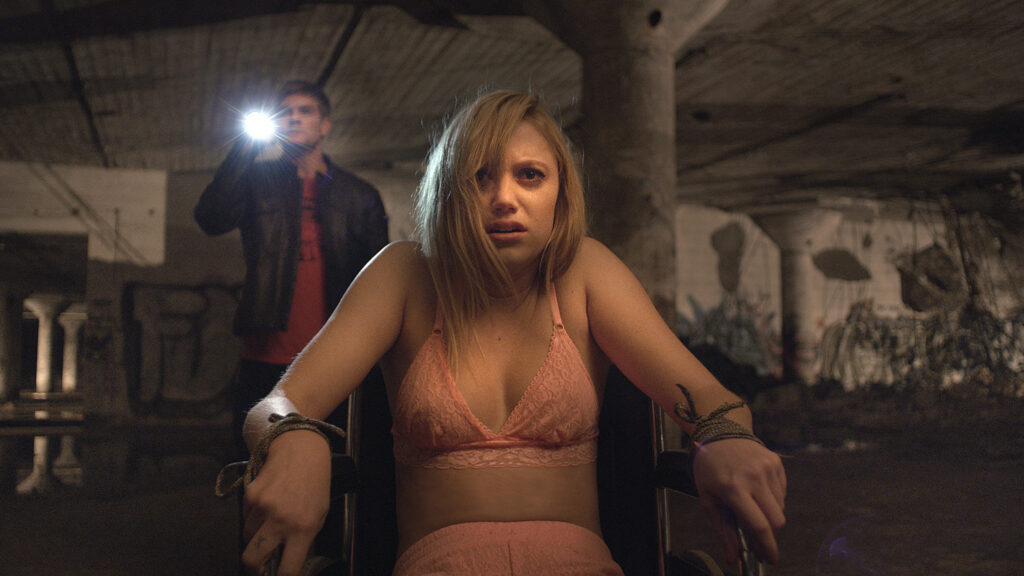
Maika Monroe has quickly established herself as one of the most exciting young actresses in modern horror, known for her roles in films that explore themes of fear, isolation, and survival. Monroe’s performances are marked by a sense of intensity and vulnerability, making her one of the most compelling figures in the genre.
Monroe’s breakout role in horror came with the film “It Follows” (2014), directed by David Robert Mitchell. “It Follows” is a supernatural horror film that explores themes of sexual anxiety, fear of the unknown, and the inescapability of death. Monroe plays Jay Height, a young woman who becomes the target of a supernatural entity after a sexual encounter. The entity, which takes the form of different people, follows its target relentlessly, and the only way to pass it on is through another sexual encounter.
Monroe’s portrayal of Jay is both haunting and relatable, as she captures the character’s fear and desperation. Jay is a character who is constantly on the run, trying to escape an unseen force that threatens her life. Monroe’s performance brings a sense of realism to the film, grounding the supernatural elements in the emotional reality of the character’s experience.
“It Follows” is notable for its unique take on the horror genre, blending elements of psychological horror, body horror, and supernatural terror. Monroe’s performance is central to the film’s success, as she navigates the complex emotions of a character who is both a victim and a fighter. Jay’s journey in the film is one of survival, and Monroe’s portrayal captures the intensity of this experience.
In addition to “It Follows,” Monroe has appeared in other horror films that showcase her range as an actress. In “The Guest” (2014), directed by Adam Wingard, she plays Anna Peterson, a young woman whose family is visited by a mysterious stranger who claims to be a friend of her deceased brother. The film is a blend of horror, thriller, and dark comedy, and Monroe’s performance as Anna is both strong and sympathetic. Her character is a central figure in the film’s unfolding mystery, and Monroe’s portrayal adds depth to the story.
Monroe’s work in horror is characterized by her ability to convey both strength and vulnerability, often playing characters who are forced to confront their deepest fears. Her performances bring a sense of authenticity to the genre, making her one of the most compelling actresses in modern horror.
Maika Monroe’s contributions to horror are significant for the way they challenge traditional narratives and explore complex themes. Her performances in films like “It Follows” and “The Guest” have made her one of the most exciting new voices in the genre, and her work continues to push the boundaries of what horror can be. Monroe’s ability to embody characters who are both relatable and terrifying has made her a standout figure in modern horror, and her influence on the genre is sure to continue in the years to come.
Conclusion: The Women Who Changed Horror Forever
The contributions of these women to the horror genre cannot be overstated. From the early days of silent films to the modern era of psychological thrillers, women have played a crucial role in shaping the horror genre and pushing its boundaries. Their performances have brought new levels of emotional depth, complexity, and authenticity to horror, challenging traditional narratives and offering new perspectives on what it means to be a woman in a genre often dominated by male perspectives.
These women have not only changed the way we view horror but have also paved the way for future generations of actresses to explore the genre. Their work has expanded the possibilities of what horror can be, making it a more diverse, inclusive, and dynamic genre. As horror continues to evolve, the influence of these women will undoubtedly continue to be felt, inspiring new voices and new stories that push the boundaries of fear and imagination.
In celebrating the women who have shaped horror, we also celebrate the genre itself, a genre that has always been a space for exploring the darkest corners of the human experience. These women have shown us that horror is not just about fear but also about resilience, strength, and the power of storytelling. Their contributions to the genre have made horror what it is today, and their legacy will continue to haunt and inspire us for generations to come.

